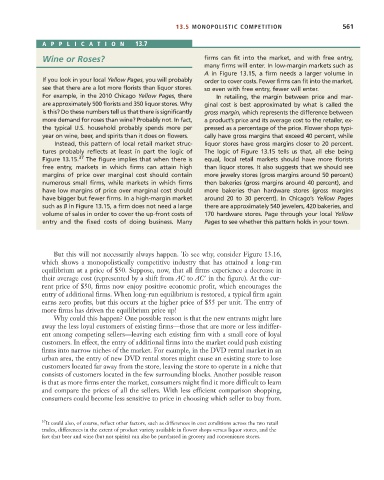Page 587 - Microeconomics, Fourth Edition
P. 587
c13marketstructureandcompetition.qxd 7/30/10 10:44 AM Page 561
13.5 MONOPOLISTIC COMPETITION 561
APPLICA TION 13.7
Wine or Roses? firms can fit into the market, and with free entry,
many firms will enter. In low-margin markets such as
A in Figure 13.15, a firm needs a larger volume in
If you look in your local Yellow Pages, you will probably order to cover costs. Fewer firms can fit into the market,
see that there are a lot more florists than liquor stores. so even with free entry, fewer will enter.
For example, in the 2010 Chicago Yellow Pages, there In retailing, the margin between price and mar-
are approximately 500 florists and 350 liquor stores. Why ginal cost is best approximated by what is called the
is this? Do these numbers tell us that there is significantly gross margin, which represents the difference between
more demand for roses than wine? Probably not. In fact, a product’s price and its average cost to the retailer, ex-
the typical U.S. household probably spends more per pressed as a percentage of the price. Flower shops typi-
year on wine, beer, and spirits than it does on flowers. cally have gross margins that exceed 40 percent, while
Instead, this pattern of local retail market struc- liquor stores have gross margins closer to 20 percent.
tures probably reflects at least in part the logic of The logic of Figure 13.15 tells us that, all else being
Figure 13.15. 37 The figure implies that when there is equal, local retail markets should have more florists
free entry, markets in which firms can attain high than liquor stores. It also suggests that we should see
margins of price over marginal cost should contain more jewelry stores (gross margins around 50 percent)
numerous small firms, while markets in which firms then bakeries (gross margins around 40 percent), and
have low margins of price over marginal cost should more bakeries than hardware stores (gross margins
have bigger but fewer firms. In a high-margin market around 20 to 30 percent). In Chicago’s Yellow Pages
such as B in Figure 13.15, a firm does not need a large there are approximately 540 jewelers, 420 bakeries, and
volume of sales in order to cover the up-front costs of 170 hardware stores. Page through your local Yellow
entry and the fixed costs of doing business. Many Pages to see whether this pattern holds in your town.
But this will not necessarily always happen. To see why, consider Figure 13.16,
which shows a monopolistically competitive industry that has attained a long-run
equilibrium at a price of $50. Suppose, now, that all firms experience a decrease in
their average cost (represented by a shift from AC to AC in the figure). At the cur-
rent price of $50, firms now enjoy positive economic profit, which encourages the
entry of additional firms. When long-run equilibrium is restored, a typical firm again
earns zero profits, but this occurs at the higher price of $55 per unit. The entry of
more firms has driven the equilibrium price up!
Why could this happen? One possible reason is that the new entrants might lure
away the less loyal customers of existing firms—those that are more or less indiffer-
ent among competing sellers—leaving each existing firm with a small core of loyal
customers. In effect, the entry of additional firms into the market could push existing
firms into narrow niches of the market. For example, in the DVD rental market in an
urban area, the entry of new DVD rental stores might cause an existing store to lose
customers located far away from the store, leaving the store to operate in a niche that
consists of customers located in the few surrounding blocks. Another possible reason
is that as more firms enter the market, consumers might find it more difficult to learn
and compare the prices of all the sellers. With less efficient comparison shopping,
consumers could become less sensitive to price in choosing which seller to buy from.
37 It could also, of course, reflect other factors, such as differences in cost conditions across the two retail
trades, differences in the extent of product variety available in flower shops versus liquor stores, and the
fact that beer and wine (but not spirits) can also be purchased in grocery and convenience stores.

